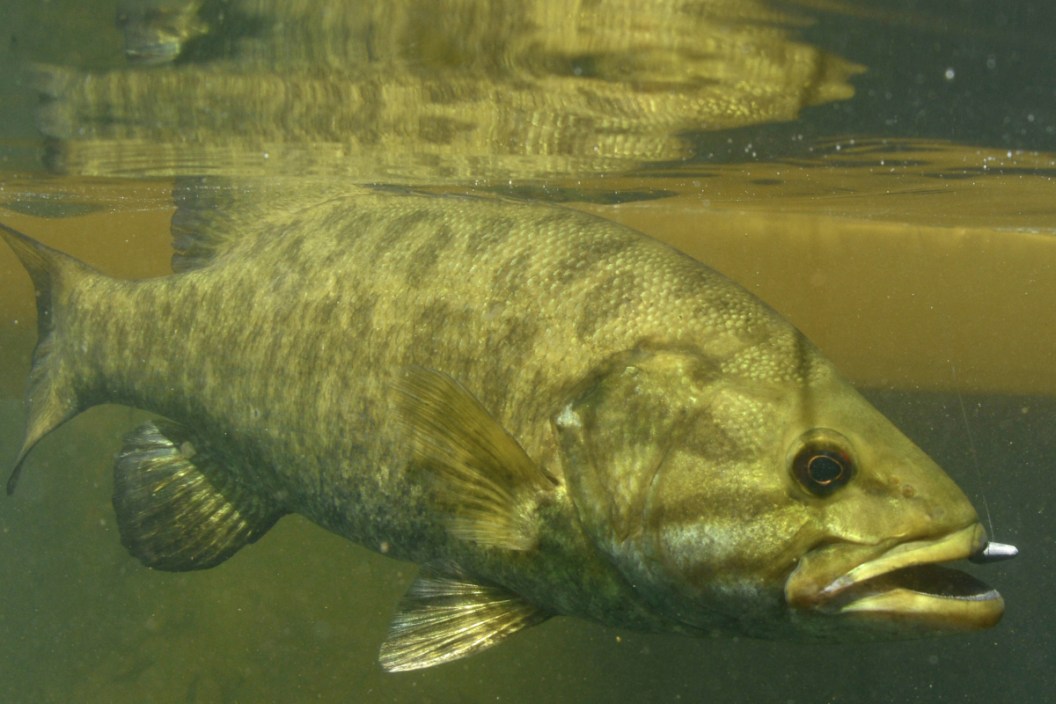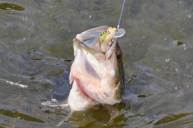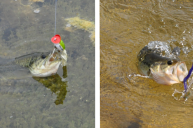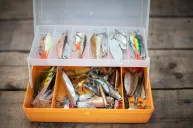What is finesse fishing and are you really doing it correctly?
Most anglers have heard the term "finesse fishing" before. These fishing techniques are especially popular in bass fishing circles. But there also seems to be some confusion at times about this style of fishing.
Don't worry, we're going to break it all down for you and discuss some of the most popular finesse techniques and how to do them properly.
Utilizing some of these finesse presentations will help you catch fish more often this fall and at other times of the year. Because it is a dynamite method to use on finicky fish.
What is finesse fishing?
At its most basic, finesse fishing is the use of lighter tackle to make a more methodical presentation to the fish. As we've already stated, these techniques are used for a variety of species, but when most people talk finesse, they're talking about fishing for bass.
Finesse fishing is a very different style from power fishing. There is almost nothing fast about it. Patience is required. But when water conditions are ripe for it, finesse fishing can produce bites when you're dealing with cold, clear water or intense fishing pressure. There is a reason so many Bassmaster tournament pros have utilized techniques like this to win the big money on tour.
Mostly finesse fishing deals with light soft plastics and jig rigs. We'll go over some of those more a little later in this article.
Equipment for finesse fishing.
These angling techniques do utilize lighter line and smaller baits, but some people get confused and associate finesse with ultralight. While that may be true if you're targeting a smaller species, it's not always the case. For bass fishing, it isn't uncommon for bass anglers to use six to 7.5-foot medium action spinning rods to tackle big smallmouth and largemouth.
Most anglers don't use monofilament for finesse fishing. Fluorocarbon is predominantly the most popular. Some anglers like to use braid with a fluorocarbon leader. That way they're getting the strength of the braid while the fluorocarbon is nearly invisible to the fish, which is what you're going for in the more subtle presentations of finesse.
Hook are lure sizes are going to vary. Just remember that smaller is usually better with finesse baits and lures. For some popular techniques, like the Ned rig, you'll find the pros using teeny jigs only 1/15 to 1/8 ounces. Many anglers like to use 3/0-size hooks for soft plastics, but keep in mind you're going to be dealing with smaller lures most of the time. You'll generally be dropping down a size or two for wacky and drop shot rigs.
With weights, many manufacturers are making specialty ones for finesse fishing now. It's easy to find a pack of drop shot weights at any tackle store, but don't discount small egg or split shot either. Sometimes that's all you need for some plastic presentations.
What size spinning reel for finesse fishing?
Spinning tackle is king when it comes to finesse fishing and many people have the same question: "What size reel should I buy?"
It's interesting that most of the best finesse fishing pros are all over the map on this one. Most seem to fall in that 25/2500 or 30/3000 reel size however. We tend to believe most of this is personal preference and situation-dependent more than anything else.
For instance, let's say you're on clear water and the fish are extremely jittery. You may have pull out a 10/1000 size reel with some extremely light 4-pound test line at some point if the fish are too scared of your presentations with the larger ones.
We'd recommend getting something in between these extremes to finesse fish, but if you can afford to have one of each in your boat, all the better. That way you can let your observations on the fish's behavior dictate the aggressiveness of the presentation.
Most of all, don't be afraid to experiment with reel sizes until you find what works best for you. Creativity and outside-the-box thinking led to the development of hot finesse techniques like the Ned rig.
Jig finesse fishing techniques.
The use of lightweight jigheads helped make finesse fishing what it is today. Some of the jigs you might see in use today might seem more like something you'd use for crappie or other panfish, but bass love inhaling these things.
We've written about the Ned rig extensively in the past. This rig uses a mushroom-shaped jighead and a short, 2-3-inch finesse worm, and that's it. Dragged across the bottom, this rig bears a strong resemblance to a minnow feeding on the bottom. You can even trim down larger plastic worms or senkos to fish in this method. It's incredibly simple, but it continually pays off. And it's not just effective during cold fronts or other times where the bass seem to develop lockjaw. It's effective all year-round in both shallow and deep water. No wonder this became a favorite finesse method seemingly overnight.
Another popular style of fishing is the use of "shaky head" jigs. Since they've been developed, manufacturers have been making these jigs at incredibly small sizes. You can buy find them sometimes down to 1/16-ounce sizes! Generally, this technique utilizes worms too, but you can also use grubs or plastic "critter" style soft plastics to try and make your lure resemble aquatic insects or crayfish.
Drop shot techniques.
Some anglers may think of catfish when they hear the term "drop shot." And the rig does resemble a catfish rig. You have a weight on a leader below a small worm on a single hook. The idea here is to let the weight hit the bottom, which suspends the worm just above and hopefully, right in the face of a hungry, big bass!
Anglers used to have to head to the catfish fishing section to find some of the components needed for drop shot fishing, but since the technique has taken off, plastic worm makers have gotten in on the action. Now, you can buy a complete "drop shot" kit from just about any tackle store. But you can also substitute a simple egg sinker or split shot for the weight. Most of the time 1/8 ounce weights will do the trick.
Most of the time, you'll be using worms no more than five inches in length. The pros tend to stick in that 4-4.5-inch range. Feel free to go bigger if the fish are being aggressive. Speaking of aggressive, you need to make sure you're not over-doing your presentation here. Remember, this is light line, light lures and usually, a very responsive rod. A little movement goes a long way, do not over-twitch the lure or retrieve it too fast. You're going for subtle with this technique and that means keeping the bait suspended just off the bottom and in the strike zone for as long as possible.
It can take a little while to get used to the slower method of fishing with a drop shot, but you'll start to settle in once you feel those first few subtle bites.
Wacky worms and other plastics.
The other method everyone associates with finesse plastics is the wacky worm rig, which has seen a huge resurgence in recent years. Use a size 2/0 or 3/0 open-style hook depending on the worm size. There are two ways to hook the worm. The first is to hook directly through the body. The second is to loop an O-ring over the worm and put hook through the O-ring. The worm might last slightly longer with the second method, but I fully believe it's more a personal preference type of thing.
This is another technique that has since developed a full line of weights and hooks designed specifically to do the job. Generally, you're sticking a small weight directly into the body. Change up the size depending on how deep the fish are.
Fishing them is simple. Cast, let the worm sink, twitch it a few times and then twitch it again. Like other finesse techniques, it is slow. But it's also effective. Just remember to again use a sweeping motion when setting the hook. You can't put a lot of force on the fish like you would with a crankbait.
Some anglers consider a Texas rig with an offset hook and cone sinker to be a finesse technique. We say, why not try it? Texas rigs generally use larger worms, but try a smaller hook, lighter weight and shorter worm the next time the fishing is slow at your favorite weight. Sometimes all it takes is something new to entice a strike.
We have found that natural colors seem to work best. Something like green pumpkin is usually a killer using these techniques. Try to match the hatch as best you can to crayfish or small baitfish for small plastic baits.
Hardbaits.
I know some people will go: "What?!?" But yep, we're talking crankbaits and jerkbaits here. These aren't generally considered to be finesse techniques, but they can be. One of my favorite lures of all time is the Rebel Crawfish crankbait. Rebel makes this bait in extremely small sizes, some of which are intended for stuff like panfish.
But a small floating crankbait like this can be dynamite when the waters are starting to heat up and the fish are beginning to feed in the spring. Most anglers tend to use a steady retrieve for a lure like this, but I like to use a reel, pause, reel style retrieve with it. For the lighter crankbaits, it produces a slow, steady wobble that's hard for bass to resist. I've had many strikes come on the pause.
It's the same line of thinking with a jerkbait, slow periods of retrieval interspaced with letting it suspend or float. You're looking to make it look like a dying baitfish with these techniques. You'd be surprised by how many big bass slurp up tiny lures like this intended for other species. But that's why bass are opportunistic predators. You may have to do some experimenting with lines and reel combos to find one that produces good action at a slower finesse speed, but it can be done.
One thing to keep in mind is that hardbaits generally will never work as well as jigs or soft plastics in the colder winter months. The fish just don't have the energy to chase them in those months.
Are you finesse fishing the right way?
Well, are you using light rods, reels and line? Are you using light lures and extremely slow presentations to skittery or lethargic fish? Then yes, you are finesse fishing. One of the great things about finesse fishing is how the term has come to be an umbrella that fits a variety of fishing techniques and styles the past few years.
The main things that don't change are that it's light gear, small lures and a slow presentation. If the fishing method you're using involves those and it's not one of the techniques we described above, we'd still say it's a finesse technique.
Finesse fishing can be difficult to do in some instances. We get it, it's a slowed-down method of fishing and if you lack patience, like I do, sometimes it can be pure torture waiting for a bite. Many of these methods also don't produce super-aggressive strikes, which means a bite can sometimes take you by surprise.
But once you've boated a few fish and you see how deadly finesse fishing can be, you'll want to start utilizing these tactics more and more often. And you'll boat more fish because of them!
Products featured on Wide Open Spaces are independently selected by our editors. However, when you buy something through our links, we may earn a commission.
For more outdoor content from Travis Smola, be sure to follow him on Twitter and check out his Geocaching and Outdoors with Travis YouTube channels.
NEXT: NED RIG: HOW TO TIE IT, FISH IT AND MAKE IT WORK
WATCH
https://rumble.com/embed/u7gve.v3v4j9/





